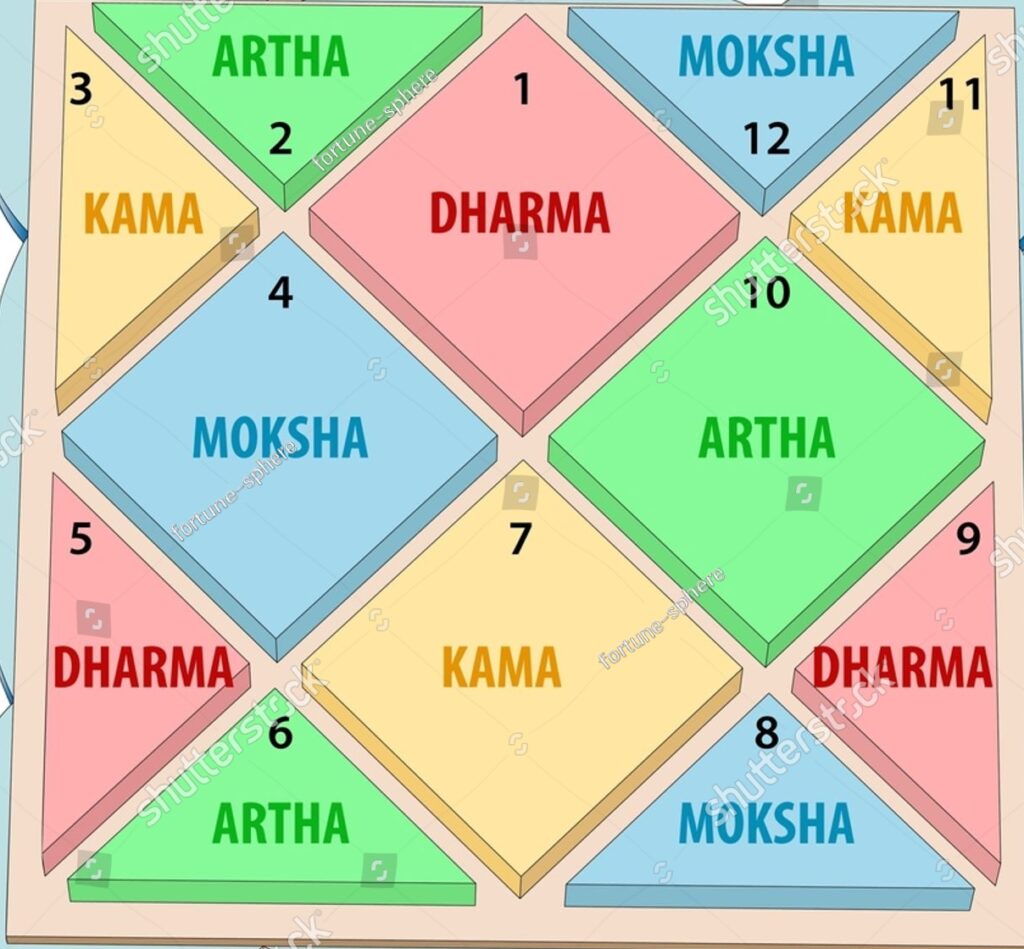As per Vedas, four Purusharthas namely Dharma, Artha, Kama and Moksha are the inherent objectives of human life; These four Purusharthas are well-depicted in the following horoscope;

Four Purusharthas: Inherent Objectives of Human Life
These four purusharthas namely Dharma, Artha, Kama & Moksha can be defined as follows: –
- Dharma means nature and righteousness; By adopting Dharma, one’s deeds or karmas can be improved;
- Artha means prosperity and economic value; By earning artha, one can fulfill one’s desires;
- Kama means pleasure, love, desires and psychological value;
- Moksha means liberation, spiritual values and self-realization; After attaining moksha, a person is freed from the cycle of birth and death;
- Dharma, Artha, Kama and Moksha are considered to be the basis of human life; It is said that the goal of human life can be achieved only by adopting these four Purusharthas;
- Dharma, Artha and Kama, these three Purusharthas are the means to attain Moksha; Trivarga Purusharthas are the activities performed by man on earth and Moksha is the result of these three activities; According to religious scriptures, after completion of the Trivarga duties of Artha, Dharma and Kama, man attains salvation and Moksha;
Depiction of Four Purusharthas in Horoscope
Consideration of different Purusharthas from different Bhavas of the Birth Chart
Astrology is the science of destiny as well as of karma; Astrology inspires us to act in the right direction; Different purusharthas are considered from different houses of the horoscope; There are twelve houses in the horoscope and all the karmas from birth to moksha are contained in these twelve houses;
The basic rules and principles of astrology are based on the four purusharthas; The natal astrology only discusses the human’s karma and its results; therefore, the explanation of the four purusharthas can be fully understood through astrology; On closer consideration, the four purusharthas in the form of dharma, artha, kama and moksha are expressed by four groups of triangles in the horoscope;
- Dharma Purushartha is represented by first house, fifth house and ninth house of the horoscope;
- Artha Purushartha is represented by second house, sixth house and tenth house of the horoscope;
- Kama Purushartha is represented by third house, seventh house and eleventh house of the horoscope;
- Moksha Purushartha is represented by fourth house, eighth house and twelfth house of the horoscope;
The relation between karma and karmaphala is based on the cause-effect principle, where karma is considered as the cause and the result as the principle; Just as work cannot be done without a cause, similarly there cannot be a result without karma; All the deeds done in the previous birth can be seen and understood very clearly with the help of astrology; Just as the light of a lamp or torch etc. in the dark reveals the things hidden in the darkness, similarly astrology shows the future of a person;
Significance of Four Purusharthas
There are four aims of human life- Artha, Dharma, Kama and Moksha; All four are equally important for life; These four together are called Chaturvidh Purushartha. Let us know the importance of these four; the consideration of different aims of human life based on different houses in the birth chart has already been discussed in the foregoing paragraphs;
According to Indian scholars, the main goal of life is to achieve Dharma, Artha, Kama & Moksha; In the Vedas, these four aims are called Purushartha or ‘Purushartha Chatushtaya’; All four are interconnected and are the pillars of human life; All four of these aims are equally important because all four complement each other; In fact, instead of calling them four, they can be called one because they are four parts of the same truth; Also, Artha and Kama are parts of materialism and Dharma and Moksha are parts of spiritualism, all four are equally important;
Ultimate goal is Moksha – It is necessary to strive for Moksha (salvation) and not focus only on Artha (wealth) among the four Purusharthas; Therefore, the three parts of Moksha-like Purushartha, namely Artha, Dharma and Kama have been placed in the category of Trivarga Purushartha in which maximum emphasis has been given on Dharma Purushartha, less on Artha Purushartha and least on Kama Purushartha; Dharma, Artha and Kama, these three Purusharthas are the means of attaining Moksha; Trivarga Purusharthas are the activities performed by man on earth and Moksha is the result of these three activities. According to religious scriptures, after completion of the Trivarga duties of Artha, Dharma and Kama, man attains salvation and Moksha. Moksha is the ultimate Purushartha in Indian concept. If a man attains Moksha (salvation), he gets liberated from the cycle of birth and death and merges into Brahma.
Note: In case of any question or doubt about the content of this article, you are free to contact through following email;
Email Me via Mobile: dilip@dknastrology.co.in
*****
Leave a Reply